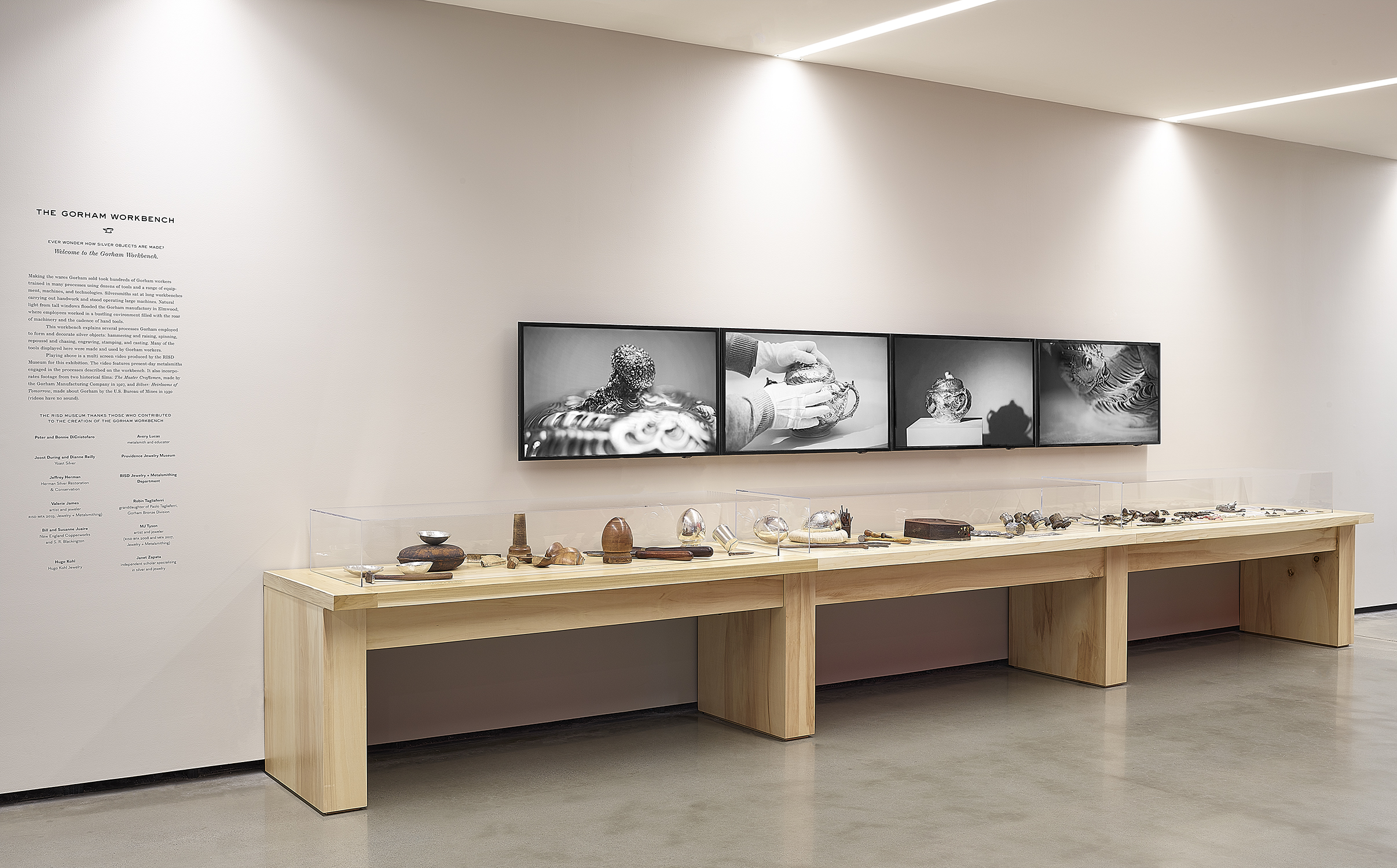Gorham Workbench
4-CHANNEL VIDEO INSTALLATION | RISD Museum
Created in conjunction with the exhibition Gorham Silver: Designing Brilliance 1850–1970. Hanging above a vitrine of Gorham tools, this thirteen-minute, four-channel installation demonstrated six key silver making techniques. While the silver pieces in the exhibition are impressive in their own right, we wanted to emphasize the human labor that went into making these objects. We mixed archival factory footage and shots of contemporary silversmiths with stylized vignettes of silver from the collection. Today, the videos live in a modified two-channel format on the museum’s website and Vimeo.
The Gorham Manufacturing Company was founded in 1831 in Providence, Rhode Island. Drawing upon industrial production techniques that were being developed in Britain, it quickly rose to prominence as a silver goods manufacturer. Mixing hand and machine production made silverware more attainable for the middle classes. If your family has a set of heirloom silverware, it was probably made by Gorham. Though Gorham closed in the late 20th century, its impact on the Rhode Island community is still felt today. Many people have a relative who worked for Gorham, and there is still a deep tradition of highly skilled metalworkers in the area, many of whom worked for or were trained by Gorham workers.
Created in conjunction with the exhibition Gorham Silver: Designing Brilliance 1850–1970. Hanging above a vitrine of Gorham tools, this thirteen-minute, four-channel installation demonstrated six key silver making techniques. While the silver pieces in the exhibition are impressive in their own right, we wanted to emphasize the human labor that went into making these objects. We mixed archival factory footage and shots of contemporary silversmiths with stylized vignettes of silver from the collection. Today, the videos live in a modified two-channel format on the museum’s website and Vimeo.
The Gorham Manufacturing Company was founded in 1831 in Providence, Rhode Island. Drawing upon industrial production techniques that were being developed in Britain, it quickly rose to prominence as a silver goods manufacturer. Mixing hand and machine production made silverware more attainable for the middle classes. If your family has a set of heirloom silverware, it was probably made by Gorham. Though Gorham closed in the late 20th century, its impact on the Rhode Island community is still felt today. Many people have a relative who worked for Gorham, and there is still a deep tradition of highly skilled metalworkers in the area, many of whom worked for or were trained by Gorham workers.
Filming this project was an incredible experience. Visually, I was informed by the short historic films we had of the Gorham factory from the 1920s and ’30s. One of these ended with a gauzy montage of spinning forks. Seeing that, I knew immediately I wanted to create a Busby Berkeley-esque silver dreamscape to introduce the silver objects. We worked with the museum photographer to create a giant lazy susan and a silver spinning rig, all encased in a massive cloth and paper tent to prevent our reflection appearing in the silver objects.
We were also lucky enough to work with a number of very knowledgeable, generous, and invested community members on this project. Local jewelers, artists, and metalsmiths demonstrated the often complex techniques. We film those contemporary artists in a way that blurred slightly with the archival footage. This emphasized the living nature of silver making processes, and connected the objects in the gallery to the tools and techniques of contemporary makers.


Other people lent the museum tools used in the Gorham factory. We filmed these tools on a spinning set of columns we built ourselves. These tools were then displayed in the gallery below the screens, along with the in-process objects created in the video. For example, to illustrate the process of spinning, we display chucks, spinning tools, silver blanks, and the final form that corresponds to the chucks. Above these objects, the video displays historic footage of spinning in the Gorham factory, alongside a modern example showing a Providence-based company spinning silver on a lathe. Whenever possible, we used actual tools from Gorham; e.g. Gorham casting dies to demonstrate the intricate casting process of the objects on view in the exhibition. That particular adventure had us driving to Virginia to find the exact Gorham machine that could fit these casting dies, as seen in the image below.
